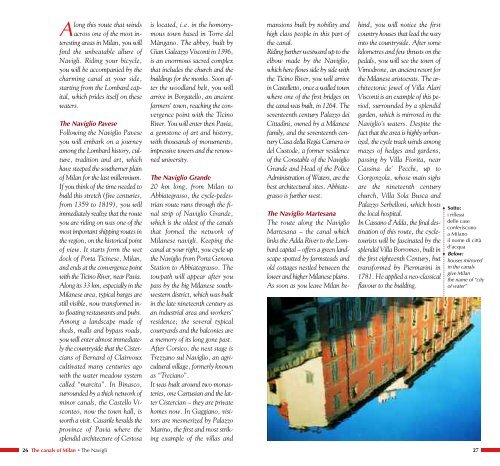mastro Orso
mastro Orso
mastro Orso
Create successful ePaper yourself
Turn your PDF publications into a flip-book with our unique Google optimized e-Paper software.
Along this route that winds<br />
across one of the most interesting<br />
areas in Milan, you will<br />
find the unbeatable allure of<br />
Navigli. Riding your bicycle,<br />
you will be accompanied by the<br />
charming canal at your side,<br />
starting from the Lombard capital,<br />
which prides itself on these<br />
waters.<br />
The Naviglio Pavese<br />
Following the Naviglio Pavese<br />
you will embark on a journey<br />
among the Lombard history, culture,<br />
tradition and art, which<br />
have steeped the southerner plain<br />
of Milan for the last millennium.<br />
If you think of the time needed to<br />
build this stretch (five centuries,<br />
from 1359 to 1819), you will<br />
immediately realize that the route<br />
you are riding on was one of the<br />
most important shipping routes in<br />
the region, on the historical point<br />
of view. It starts form the wet<br />
dock of Porta Ticinese, Milan,<br />
and ends at the convergence point<br />
with the Ticino River, near Pavia.<br />
Along its 33 km, especially in the<br />
Milanese area, typical barges are<br />
still visible, now transformed into<br />
floating restaurants and pubs.<br />
Among a landscape made of<br />
sheds, malls and bypass roads,<br />
you will enter almost immediately<br />
the countryside that the Cistercians<br />
of Bernard of Clairvoux<br />
cultivated many centuries ago<br />
with the water meadow system<br />
called “marcita”. In Binasco,<br />
surrounded by a thick network of<br />
minor canals, the Castello Visconteo,<br />
now the town hall, is<br />
worth a visit. Casarile heralds the<br />
province of Pavia where the<br />
splendid architecture of Certosa<br />
is located, i.e. in the homonymous<br />
town based in Torre del<br />
Màngano. The abbey, built by<br />
Gian Galeazzo Visconti in 1396,<br />
is an enormous sacred complex<br />
that includes the church and the<br />
buildings for the monks. Soon after<br />
the woodland belt, you will<br />
arrive in Borgatello, an ancient<br />
farmers’ town, reaching the convergence<br />
point with the Ticino<br />
River. You will enter then Pavia,<br />
a gemstone of art and history,<br />
with thousands of monuments,<br />
impressive towers and the renowned<br />
university.<br />
The Naviglio Grande<br />
20 km long, from Milan to<br />
Abbiategrasso, the cycle-pedestrian<br />
route runs through the final<br />
strip of Naviglio Grande,<br />
which is the oldest of the canals<br />
that formed the network of<br />
Milanese navigli. Keeping the<br />
canal at your right, you cycle up<br />
the Naviglio from Porta Genova<br />
Station to Abbiategrasso. The<br />
towpath will appear after you<br />
pass by the big Milanese southwestern<br />
district, which was built<br />
in the late nineteenth century as<br />
an industrial area and workers’<br />
residence; the several typical<br />
courtyards and the balconies are<br />
a memory of its long gone past.<br />
After Corsico, the next stage is<br />
Trezzano sul Naviglio, an agricultural<br />
village, formerly known<br />
as “Treciano”.<br />
It was built around two monasteries,<br />
one Cartusian and the latter<br />
Cistercian – they are private<br />
homes now. In Gaggiano, visitors<br />
are mesmerized by Palazzo<br />
Marino, the first and most striking<br />
example of the villas and<br />
mansions built by nobility and<br />
high class people in this part of<br />
the canal.<br />
Riding further westward up to the<br />
elbow made by the Naviglio,<br />
which here flows side by side with<br />
the Ticino River, you will arrive<br />
in Castelletto, once a walled town<br />
where one of the first bridges on<br />
the canal was built, in 1264. The<br />
seventeenth century Palazzo dei<br />
Cittadini, owned by a Milanese<br />
family, and the seventeenth century<br />
Casa della Regia Camera or<br />
del Custode, a former residence<br />
of the Constable of the Naviglio<br />
Grande and Head of the Police<br />
Administration of Waters, are the<br />
best architectural sites. Abbiategrasso<br />
is further west.<br />
The Naviglio Martesana<br />
The route along the Naviglio<br />
Martesana – the canal which<br />
links the Adda River to the Lombard<br />
capital – offers a green landscape<br />
spotted by farmsteads and<br />
old cottages nestled between the<br />
lower and higher Milanese plains.<br />
As soon as you leave Milan behind,<br />
you will notice the first<br />
country houses that lead the way<br />
into the countryside. After some<br />
kilometres and few thrusts on the<br />
pedals, you will see the town of<br />
Vimodrone, an ancient resort for<br />
the Milanese aristocrats. The architectonic<br />
jewel of Villa Alari<br />
Visconti is an example of this period,<br />
surrounded by a splendid<br />
garden, which is mirrored in the<br />
Naviglio’s waters. Despite the<br />
fact that the area is highly urbanized,<br />
the cycle track winds among<br />
mazes of hedges and gardens,<br />
passing by Villa Fiorita, near<br />
Cassina de’ Pecchi, up to<br />
Gorgonzola, whose main sighs<br />
are the nineteenth century<br />
church, Villa Sola Busca and<br />
Palazzo Serbelloni, which hosts<br />
the local hospital.<br />
In Cassano d’Adda, the final destination<br />
of this route, the cycletourists<br />
will be fascinated by the<br />
splendid Villa Borromeo, built in<br />
the first eighteenth Century, but<br />
transformed by Piermarini in<br />
1781. He applied a neo-classical<br />
flavour to the building.<br />
• Sotto:<br />
i riflessi<br />
delle case<br />
conferiscono<br />
a Milano<br />
il nome di città<br />
d’acqua<br />
• Below:<br />
houses mirrored<br />
in the canals<br />
give Milan<br />
the name of “city<br />
of water”<br />
26 The canals of Milan • The Navigli<br />
27
















